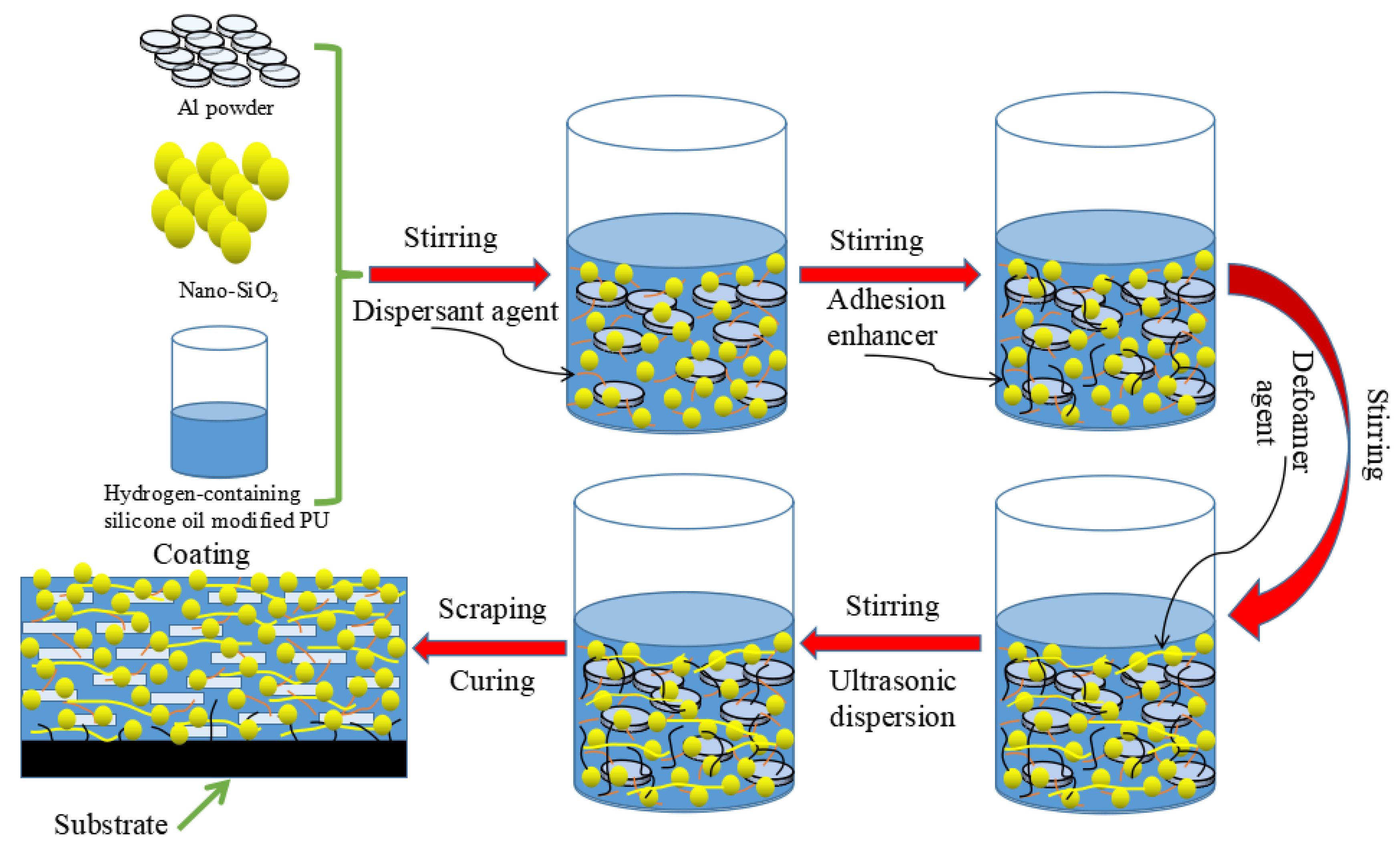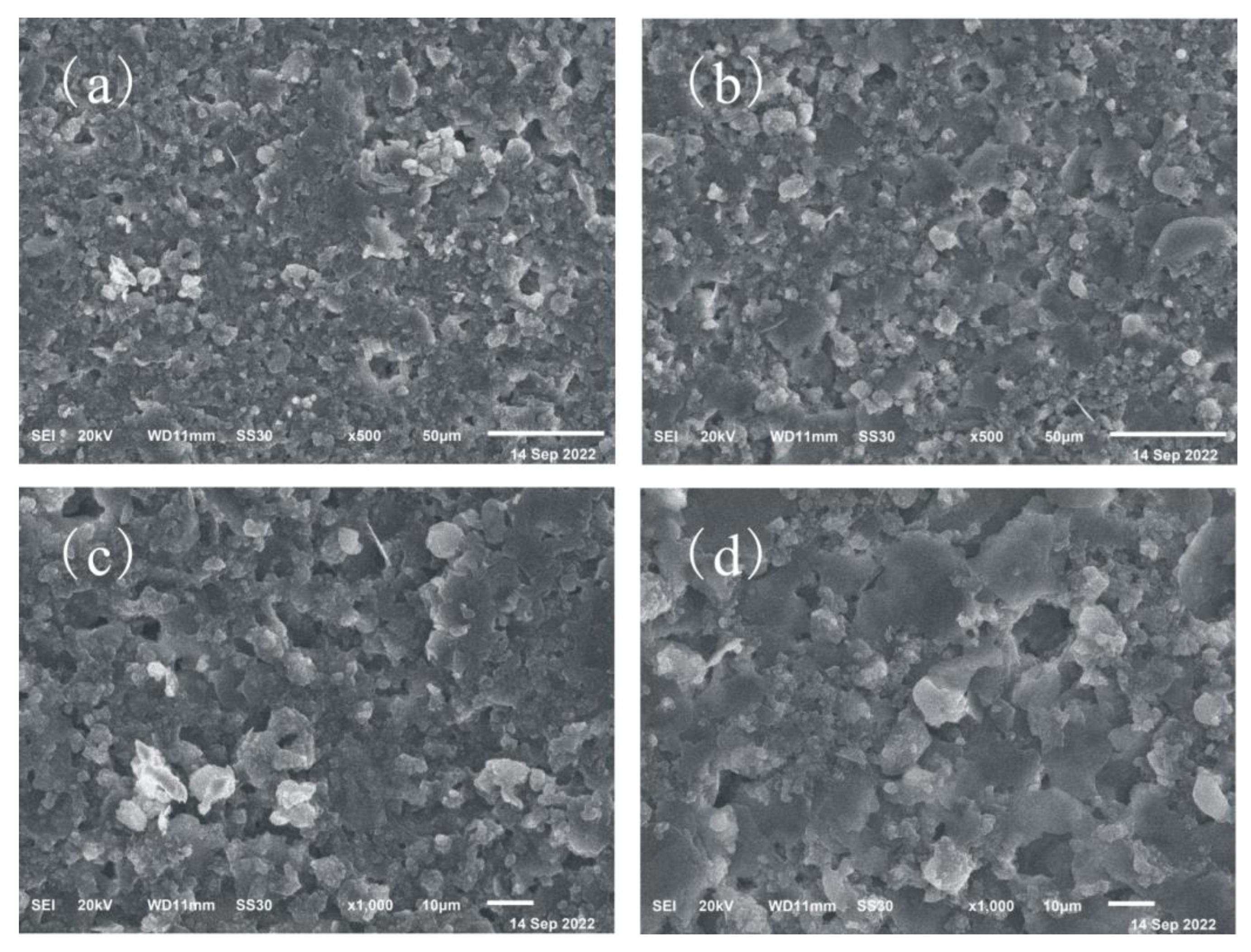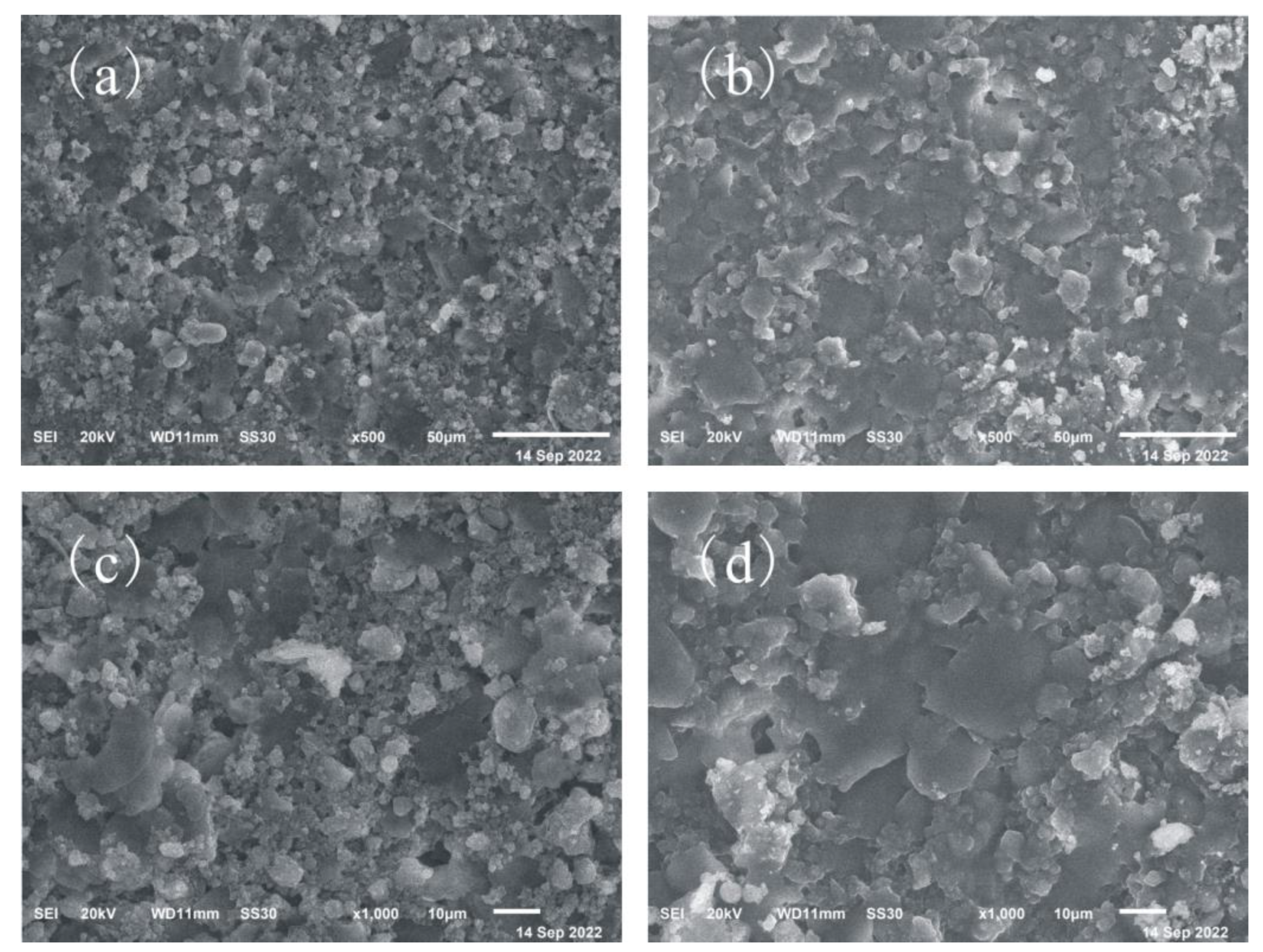The Effect of Coating Additives on the Properties of Hydrophobic Coatings with Low Infrared Emissivity
Abstract
:1. Introduction
2. Materials and Methods
2.1. Materials
2.2. Preparation of the Coating
2.3. Characterization
3. Results and Discussion
3.1. Effect of Dispersant on Coating Performance
3.2. Effect of Adhesion Enhancer on Coating Performance
3.3. Effect of Defoamer on Coating Performance
4. Conclusions
Author Contributions
Funding
Institutional Review Board Statement
Informed Consent Statement
Data Availability Statement
Conflicts of Interest
References
- Ma, D.; Xie, Y.; Wang, L.; Peng, Y.; Yin, Y.; Wang, X.; Liu, B.; Zhang, G.; Zhu, L.; Xu, D. Layered La2Zr2O7 flexible fibrous membrane for super thermal insulation and infrared stealth. Chem. Eng. J. 2023, 468, 143488. [Google Scholar] [CrossRef]
- Lyu, J.; Liu, Z.W.; Wu, X.H.; Li, G.Y.; Fang, D. Nanofibrous kevlar aerogel films and their phase-change composites for highly efficient infrared stealth. ACS Nano 2019, 13, 2236–2245. [Google Scholar] [CrossRef]
- Phan, L.; Walkup IV, W.G.; Ordinario, D.D.; Karshalev, E.; Jocson, J.M.; Burke, A.M.; Gorodetsky, A.A. Reconfigurable infrared camouflage coatings from a cephalopod protein. Adv. Mater. 2013, 25, 5621–5625. [Google Scholar] [CrossRef] [PubMed] [Green Version]
- Fang, S.J.; Wang, W.; Yu, X.; Xu, H.; Zhong, Y.; Sui, X.; Zhang, L.; Mao, Z. Preparation of ZnO:(Al, La)/polyacrylonitrile (PAN) nonwovens with low infrared emissivity via electrospinning. Mater. Lett. 2015, 143, 120–123. [Google Scholar] [CrossRef]
- Solovyev, A.A.; Rabotkin, S.V.; Kovsharov, N.F. Polymer films with multilayer low-E coatings. Mat. Sci. Semicon. Proc. 2015, 38, 373–380. [Google Scholar] [CrossRef]
- Wang, L.; Xu, G.; Liu, C.; Hou, H.; Tan, S. Surface-modified CeO2 coating with excellent thermal shock resistance performance and low infrared emissivity at high-temperature. Surf. Coat. Technol. 2019, 357, 559–566. [Google Scholar] [CrossRef]
- Zhang, W.G.; Lv, D.D. Preparation and characterization of Ge/TiO2 one-dimensional photonic crystal with low infrared emissivity in the 8–14 μm band. Mater. Res. Bull. 2020, 124, 110747. [Google Scholar] [CrossRef]
- Chen, X.T.; Zhou, M.; Zhao, Y.; Gu, W.H.; Wu, Y.; Tang, S.L.; Ji, G.B. Morphology control of eco-friendly chitosan-derived carbon aerogels for efficient microwave absorption at thin thickness and thermal stealth. Green Chem. 2022, 24, 5280–5290. [Google Scholar] [CrossRef]
- Zhou, H.P.; Yu, M.J.; Zhu, M.N.; Zheng, Q.; Xu, Y. Difunctional composite coatings with low infrared emissivity and electrostatic dissipation property. Infrared Phys. Technol. 2021, 113, 103609. [Google Scholar] [CrossRef]
- Luo, H.; Zhang, X.; Huang, S.; Shan, D.; Liao, C. Infrared emissivity and microwave transmission behavior of flaky aluminum functionalized pyramidal-frustum shaped periodic structure. Infrared Phys. Technol. 2019, 99, 123–128. [Google Scholar] [CrossRef]
- Yu, H.J.; Xu, G.Y.; Shen, X.M. Low infrared emissivity of polyurethane/Cu composite coatings. Appl. Surf. Sci. 2009, 255, 6077–6081. [Google Scholar] [CrossRef]
- Zhang, W.G.; Xu, G.Y.; Ding, R.Y. Microstructure, optimum pigment content and low infrared emissivity of polyurethane/Ag composite coatings. Physica B 2013, 422, 36–39. [Google Scholar] [CrossRef]
- Yan, X.X.; Xu, G.Y. Influence of silane coupling agent on corrosion-resistant property in low infrared emissivity Cu/polyurethane coating. Prog. Org. Coat. 2012, 73, 232–238. [Google Scholar] [CrossRef]
- Liu, Z.; Ban, G.; Ye, S.; Liu, W.; Liu, N.; Tao, R. Infrared emissivity properties of infrared stealth coatings prepared by water-based technologies. Opt. Mater. Express 2016, 6, 3716–3724. [Google Scholar] [CrossRef]
- Zhang, W.G.; Ma, Z.W.; Lv, D.D.; Luo, J.W.; Li, J. An ultra-low infrared emissivity composite coating with outstanding mechanical properties and salt water resistance. Infrared Phys. Technol. 2022, 126, 104351. [Google Scholar] [CrossRef]
- Fantucci, S.; Serra, V. Investigating the performance of reflective insulation and low emissivity paints for the energy retrofit of roof attics. Energ. Build. 2019, 182, 300–310. [Google Scholar] [CrossRef]
- Pawar, P.G.; Xing, R.; Kambale, R.C.; Kumar, A.M.; Liu, S.; Latthe, S.S. Polystyrene assisted superhydrophobic silica coatings with surface protection and self-cleaning approach. Prog. Org. Coat. 2017, 105, 235–244. [Google Scholar] [CrossRef]
- Satapathy, M.; Varshney, P.; Nanda, D.; Mohapatraa, S.S.; Beherab, A.; Kumar, A. Fabrication of durable porous and non-porous superhydrophobic LLDPE/SiO2 nanoparticles coatings with excellent self-cleaning property. Surf. Coat. Technol. 2018, 341, 31–39. [Google Scholar] [CrossRef]
- Ye, X.X.; Gui, Y.W.; Ke, L.; Gao, K.Y.; Huang, X.; Shi, B. Fabrication of 3D porous superhydrophobic sponges using plant polyphenol-Fe3+ complexes as adhesive and their applications in oil/water separation. Golloid. Surface. A 2018, 551, 9–16. [Google Scholar] [CrossRef]
- Li, C.; Sun, Y.; Cheng, M.; Sun, S.; Hu, S. Fabrication and characterization of a TiO2/polysiloxane resin composite coating with full-thickness super- hydrophobicity. Chem. Eng. J. 2018, 333, 361–369. [Google Scholar] [CrossRef]
- Wang, Z.; Shen, X.; Yan, Y.; Qian, T.; Wang, T.; Sun, J.; Jin, Q. Facile fabrication of a PDMS @ stearic acid-Al(OH)3 coating on lignocellulose composite with superhydrophobicity and flame retardancy. Appl. Surf. Sci. 2018, 450, 387–395. [Google Scholar] [CrossRef]
- Liu, Y.; Li, S.; Zhang, J.; Wang, Y.; Han, Z.; Ren, L. Fabrication of biomimetic superhydrophobic surface with controlled adhesion by electrodeposition. Chem. Eng. J. 2014, 248, 440–447. [Google Scholar] [CrossRef]
- Zhang, W.G.; Zheng, M.Y.; Lv, D.D. Preparation and performance characterization of superhydrophobic low infrared emissivity composite coating. Surf. Technol. 2020, 49, 105–111. (In Chinese) [Google Scholar]
- Wang, X.Y.; Zhang, J.Q.; Liu, J.C.; Luo, J. Phytic acid-based adhesion promoter for UV-curable coating: High performance, low cost, and eco-friendliness. Prog. Org. Coat. 2022, 167, 106834. [Google Scholar] [CrossRef]
- Mei, S.Q.; Zhou, C.; Hu, Z.K.; Xiao, Z.; Zheng, Q.; Chai, X.H. Preparation of a Ni-P-nanoPTFE Composite Coating on the Surface of GCr15 Steel for Spinning Rings via a Defoamer and Transition Layer and Its Wear and Corrosion Resistance. Materials 2023, 16, 124427. [Google Scholar] [CrossRef]







| Amounts of Dispersant/wt% | Emissivity | Glossiness | Adhesion Strength/Grade | Impact Strength/kg·cm |
|---|---|---|---|---|
| 0 | 0.585 | 3.0 | 5 | 10 |
| 1 | 0.583 | 4.3 | 5 | 10 |
| 3 | 0.535 | 4.8 | 3 | 15 |
| 5 | 0.538 | 5.0 | 2 | 20 |
| 7 | 0.541 | 5.4 | 2 | 20 |
| Amounts of Adhesion Enhancer/wt% | Emissivity | Glossiness | Adhesion Strength/Grade | Impact Strength/kg·cm |
|---|---|---|---|---|
| 0 | 0.538 | 5.0 | 2 | 20 |
| 2 | 0.520 | 5.6 | 2 | 20 |
| 3 | 0.508 | 5.7 | 1 | 25 |
| 4 | 0.508 | 5.0 | 1 | 30 |
| 5 | 0.511 | 6.1 | 1 | 30 |
| Amounts of Defoamer/wt% | Emissivity | Glossiness | Adhesion Strength/Grade | Impact Strength/kg·cm |
|---|---|---|---|---|
| 0 | 0.508 | 5.0 | 1 | 30 |
| 1 | 0.527 | 4.3 | 1 | 40 |
| 3 | 0.563 | 4.7 | 1 | 40 |
| 5 | 0.582 | 4.8 | 1 | 40 |
Disclaimer/Publisher’s Note: The statements, opinions and data contained in all publications are solely those of the individual author(s) and contributor(s) and not of MDPI and/or the editor(s). MDPI and/or the editor(s) disclaim responsibility for any injury to people or property resulting from any ideas, methods, instructions or products referred to in the content. |
© 2023 by the authors. Licensee MDPI, Basel, Switzerland. This article is an open access article distributed under the terms and conditions of the Creative Commons Attribution (CC BY) license (https://creativecommons.org/licenses/by/4.0/).
Share and Cite
Zhang, W.; Li, X.; Lv, D. The Effect of Coating Additives on the Properties of Hydrophobic Coatings with Low Infrared Emissivity. Coatings 2023, 13, 1428. https://doi.org/10.3390/coatings13081428
Zhang W, Li X, Lv D. The Effect of Coating Additives on the Properties of Hydrophobic Coatings with Low Infrared Emissivity. Coatings. 2023; 13(8):1428. https://doi.org/10.3390/coatings13081428
Chicago/Turabian StyleZhang, Weigang, Xiang Li, and Dandan Lv. 2023. "The Effect of Coating Additives on the Properties of Hydrophobic Coatings with Low Infrared Emissivity" Coatings 13, no. 8: 1428. https://doi.org/10.3390/coatings13081428
APA StyleZhang, W., Li, X., & Lv, D. (2023). The Effect of Coating Additives on the Properties of Hydrophobic Coatings with Low Infrared Emissivity. Coatings, 13(8), 1428. https://doi.org/10.3390/coatings13081428





